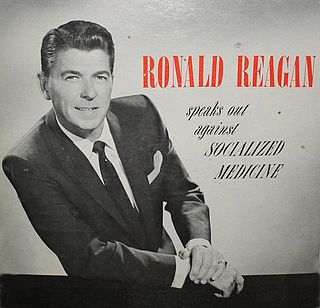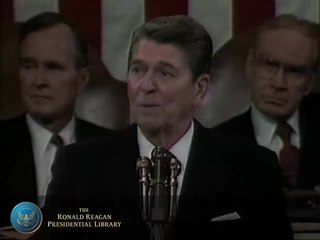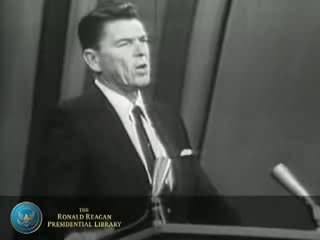 W
WThe speeches and debates of Ronald Reagan comprise the seminal oratory of the 40th President of the United States. Reagan began his career in Iowa as a radio broadcaster. In 1937, he moved to Los Angeles where he started acting, first in films and later television. After delivering a stirring speech in support of Barry Goldwater's presidential candidacy in 1964, he was persuaded to seek the California governorship, winning two years later and again in 1970. In 1980, as the Republican nominee for president of the United States, he defeated incumbent Jimmy Carter. He was reelected in a landslide in 1984, proclaiming that it was "Morning in America". Reagan left office in 1989.
 W
WThe "Evil Empire" speech was a speech delivered by U.S. President Ronald Reagan to the National Association of Evangelicals in 1983 during the Cold War. In that speech, Reagan referred to the Soviet Union as an "evil empire" and as "the focus of evil in the modern world". Reagan explicitly rejected the notion that the United States and the Soviet Union were equally responsible for the Cold War and the ongoing nuclear arms race between the two nations; rather, he asserted that the conflict was a battle between good and evil.
 W
WThe first inauguration of Ronald Reagan as the 40th president of the United States was held on Tuesday, January 20, 1981, at the West Front of the United States Capitol in Washington, D.C. This was the first inauguration to be held on the building's west side. This was the 49th inauguration and marked the commencement of the first term of Ronald Reagan as President and of George H. W. Bush as Vice President. Chief Justice Warren E. Burger administered the presidential oath of office to Reagan, who placed his hand upon a family Bible given to him by his mother, open to 2 Chronicles 7:14. Associate Justice Potter Stewart administered the vice-presidential oath to Bush.
 W
WThe second inauguration of Ronald Reagan as President of the United States was held in a small televised ceremony on Sunday, January 20, 1985, at the Grand Foyer of the White House, and was to be repeated the following day, January 21, 1985 at the West Front of the United States Capitol in Washington, D.C., before being moved to the Capitol's rotunda. This was the 50th inauguration and marked the commencement of the second and final four-year term of both Ronald Reagan as President and of George H. W. Bush as Vice President. At 73 years, 349 days of age on Inauguration Day, Reagan was the oldest U.S. president to date to be sworn in.
 W
WAs part of his 1980 presidential campaign, Ronald Reagan made an appearance at the Neshoba County Fair where he gave a speech on August 3, 1980. Critics claim that Reagan's choice of location for the speech was evidence of racial bias.
 W
WRonald Reagan Speaks Out Against Socialized Medicine is a 1961 LP featuring the actor Ronald Reagan. In this more than ten-minute recording, Reagan "criticized Social Security for supplanting private savings and warned that subsidized medicine would curtail Americans' freedom" and that "pretty soon your son won't decide when he's in school, where he will go or what he will do for a living. He will wait for the government to tell him." Roger Lowenstein called the LP part of a "stealth program" conducted by the American Medical Association.
 W
WThe 1988 State of the Union Address was given by the 40th President of the United States, Ronald Reagan, on Monday, January 25, 1988, at 9 p.m. EST, in the chamber of the United States House of Representatives to the 100th United States Congress. It was Reagan's seventh and final State of the Union Address and his eighth and final speech to a joint session of the United States Congress. Presiding over this joint session was the House Speaker, Jim Wright, accompanied by George H. W. Bush, the Vice President of the United States.
 W
WThe 1982 State of the Union Address was given by the 40th President of the United States, Ronald Reagan, on Tuesday, January 26, 1982, at 9 p.m. EST, in the chamber of the United States House of Representatives to the 97th United States Congress. It was Reagan's first State of the Union Address and his second speech to a joint session of the United States Congress. Presiding over this joint session was the House Speaker, Tip O'Neill, accompanied by George H. W. Bush, the Vice President of the United States.
 W
WThe 1983 State of the Union Address was given by the 40th President of the United States, Ronald Reagan, on Tuesday, January 25, 1983, at 9 p.m. EST, in the chamber of the United States House of Representatives to the 98th United States Congress. It was Reagan's second State of the Union Address and his third speech to a joint session of the United States Congress. Presiding over this joint session was the House Speaker, Tip O'Neill, accompanied by George H. W. Bush, the Vice President of the United States.
 W
WThe 1984 State of the Union Address was given by the 40th President of the United States, Ronald Reagan, on Wednesday, January 25, 1984, at 9 p.m. EST, in the chamber of the United States House of Representatives to the 98th United States Congress. It was Reagan's third State of the Union Address and his fourth speech to a joint session of the United States Congress. Presiding over this joint session was the House Speaker, Tip O'Neill, accompanied by George H. W. Bush, the Vice President of the United States.
 W
WThe 1985 State of the Union Address was given by the 40th President of the United States, Ronald Reagan, on Wednesday, February 6, 1985, at 9 p.m. EST, in the chamber of the United States House of Representatives to the 99th United States Congress. It was Reagan's fourth State of the Union Address and his fifth speech to a joint session of the United States Congress. Presiding over this joint session was the House Speaker, Tip O'Neill, accompanied by George H. W. Bush, the Vice President of the United States.
 W
WThe 1986 State of the Union Address was given by the 40th President of the United States, Ronald Reagan, on Tuesday, February 4, 1986, at 9 p.m. EST, in the chamber of the United States House of Representatives to the 99th United States Congress. It was Reagan's fifth State of the Union Address and his sixth speech to a joint session of the United States Congress. Presiding over this joint session was the House Speaker, Tip O'Neill, accompanied by George H. W. Bush, the Vice President of the United States.
 W
WThe 1987 State of the Union Address was given by the 40th President of the United States, Ronald Reagan, on Tuesday, January 27, 1987, at 9 p.m. EST, in the chamber of the United States House of Representatives to the 100th United States Congress. It was Reagan's sixth State of the Union Address and his seventh speech to a joint session of the United States Congress. Presiding over this joint session was the House Speaker, Jim Wright, accompanied by George H. W. Bush, the Vice President of the United States.
 W
W"Tear down this wall", also known as the Berlin Wall Speech, was a speech delivered by United States President Ronald Reagan in West Berlin on June 12, 1987. Reagan called for the General Secretary of the Communist Party of the Soviet Union, Mikhail Gorbachev, to open the Berlin Wall, which had separated West and East Berlin since 1961. The name is derived from a key line in the middle of the speech: "Mr. Gorbachev, tear down this wall!"
 W
W"A Time for Choosing", also known as "The Speech", was a speech presented during the 1964 U.S. presidential election campaign by future president Ronald Reagan on behalf of Republican candidate Barry Goldwater. The speech launched Reagan into national prominence.